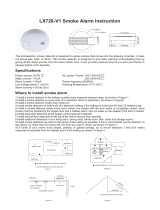5
CAUTION:
(As required by the California State Fire Marshall)
“Early warning fire detection is best achieved by the installation of fire detection equipment
in all rooms and areas of the household as follows: (1) A smoke and heat detector installed
in each separate sleeping area (in the vicinity, but outside of the bedrooms), and (2) Heat
or smoke and heat detectors in the living rooms, dining rooms, bedrooms, kitchens,
hallways, attics, furnace rooms, closets, utility and, storage rooms, basements and
attached garages.”
For your information, NFPA Standard 74, Section 2-4 reads as follows:
“2-4.1.1 Smoke and heat detectors shall be installed outside of each separate sleeping
area in the immediate vicinity of the bedrooms and on each additional story of the family
living unit including basements and excluding crawl spaces and unfinished attics.“
The provisions of 2-4.1.1 represent the minimum number of detectors required by this
standard. It is recommended that the householder consider the use of additional smoke
and heat detectors for increased protection for those areas separated by a door from the
areas protected by the required smoke and heat detectors under 2-4.1.1 above. The
recommended additional areas are living room, dining room, bedroom(s), kitchen, attic
(finished or unfinished), furnace rooms, utility room, basement, integral or attached
garage, and hallways not included in 2-4.1.1 above. However, the use of additional
detectors remains the option of the householder.” We recommend complete coverage and
use of additional smoke and heat detectors.
WHERE NOT TO INSTALL YOUR SMOKE AND HEAT
DETECTORS
False alarms occur when smoke and heat detectors are installed where they
will not work properly. To avoid false alarms, do not install smoke and heat
detectors as follows:
In the path of fresh air intake. The in-and-out flow of fresh air can drive
smoke away from the smoke and heat detector; thus reducing its efficiency.
Figure 6 indicates the correct and incorrect locations concerning this
problem.
Near paint thinner fumes.
In close proximity to an automobile exhaust pipe, as this will damage the
detector.
In very cold or very hot areas, including unheated buildings or outdoor
rooms. If the temperature goes above or below the detection range of the
smoke and heat detector, it will not work properly. This detection range is
40°F to 100°F (4°C to 38°C).
Near fresh air vents or very drafty areas like air conditioners, heaters or
fans. Fresh air vents and drafts can drive smoke away from smoke and
heat detectors.

















